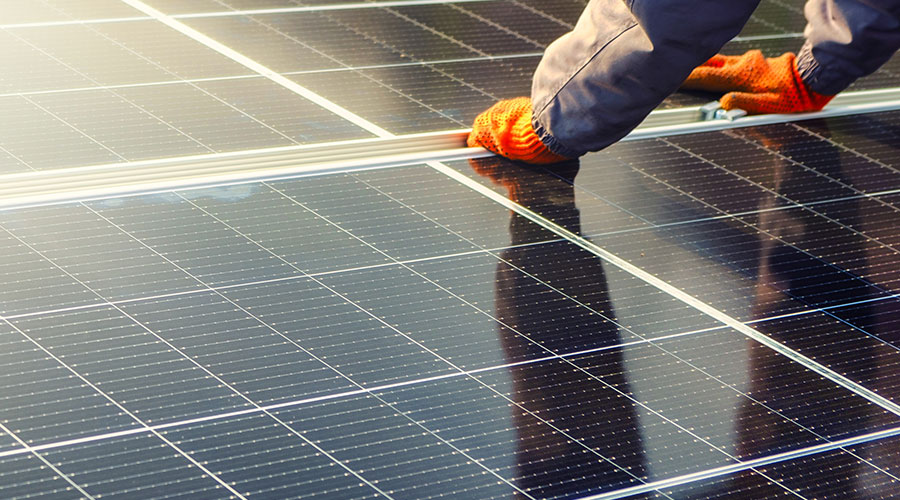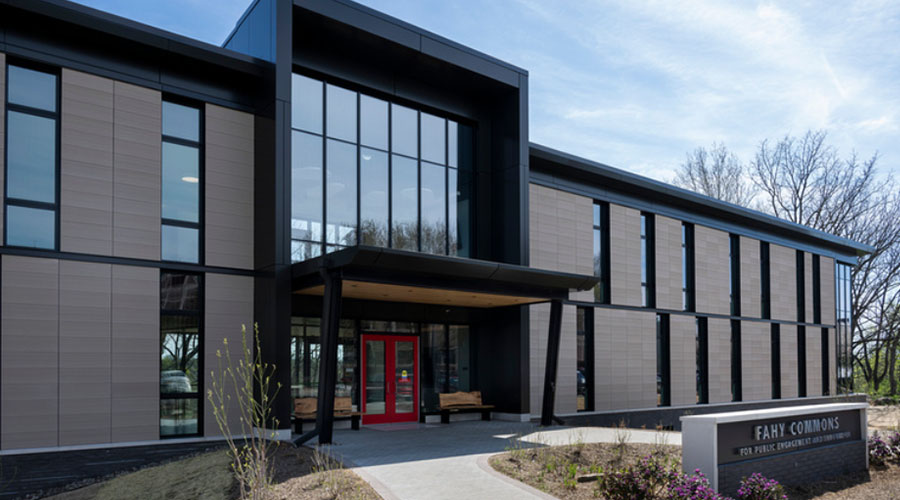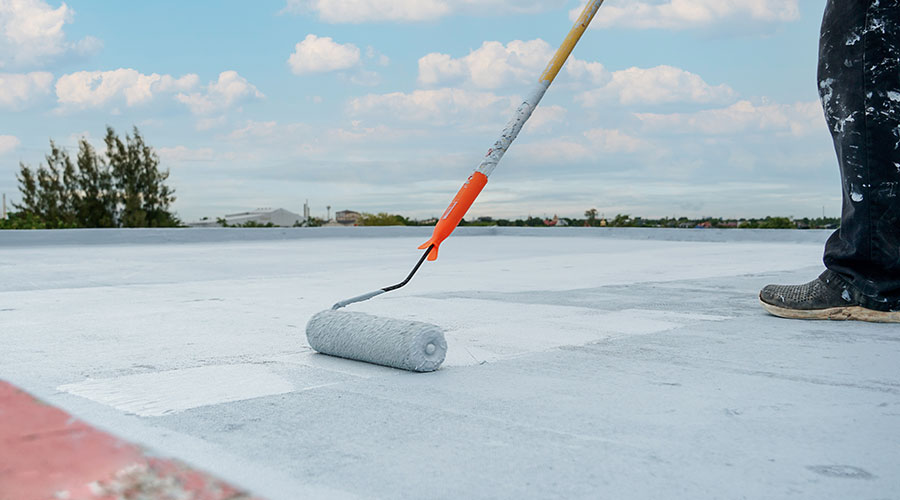Evaluating Vinyl Roofing
Energy efficiency and durability are among the factors facility executives should weigh
Installing a new roof means weighing a variety of factors to identify the best system for the building. Among the important issues to consider are design flexibility, track record of installed systems, fire resistance, energy-savings potential and ease of maintenance and repairs. Facilities executives who count those factors among the priorities for a roof should consider vinyl roofing systems.
Vinyl roofing is classified as a thermoplastic system. One important functional attribute of these systems is that the seams are welded with hot air. When properly done, heat-welding creates seams that are stronger than the membrane itself. As a result, the seams have great peel and shear strength and are less likely to deteriorate over time. Thermoplastic seams generally last throughout the membrane’s service life.
“Seaming can be a weak link in membrane roofing,” says Drew Ballensky, general manager of Duro-Last.
“At the molecular level, heat-welding actually fuses the material,” says Jerry Beall, product manager for FiberTite Roofing Systems, Seaman Corp. “When vinyl membranes are welded properly, those seams will never leak.”
It’s easy to inspect seams on a vinyl membrane to see that they are properly fused. “That brings a certain level of comfort to not just building owners but also the roofing contractor,” says Beall. “If heat-welding is done properly, the contractor is not going to have to come back and chase down seam problems.”
Jay Thomas, director of marketing for Sarnafil, agrees. “Heat-welded seams contribute to vinyl roofing membranes’ long service life and low maintenance costs.”
Good roofing design relies on proper drainage to reduce ponding on rooftops. But should water accidentally pond, a vinyl membrane offers a good defense against leaks. In fact, vinyl membranes have been used in waterproofing applications for more than 30 years, thanks in part to the heat-welded seams.
“Unlike many alternative roofing systems, neither solvent wiping nor solvent-based adhesives are needed for seaming,” says Carl De Leon, market manager, construction, for Canadian-General Tower Ltd. “There’s also no need for torches, open flames and kettles with vinyl systems.”
Some roofing products need to be installed during warmer weather so that adhesives can set properly, but a vinyl membrane’s heat-welded seams allow it to be installed almost any time of the year.
Vinyl membranes provide a variety of installation options to meet the needs of the project, including systems with no VOCs. “Vinyl roofing can be an ideal option for schools and hospitals or any occupied building,” says Jon Apgar, vice president, sales and marketing, for GenFlex Roofing Systems, a business of OMNOVA Solutions Inc. “The roofing contractors can complete the installation while the school is in session without affecting the students.”
Fire resistance characteristics
Vinyl roofing membranes are inherently flame-resistant and do not support combustion when the source of the flame is removed. As a result, vinyl roofs have passed both Factory Mutual and Underwriters Laboratories fire testing and often can be installed in high-slope as well as low-slope applications.
Vinyl was selected as the roofing material for the National Fire Protection Association’s (NFPA) headquarters building in Quincy, Mass. In NFPA’s eight-story building, fire codes and standards for building operations, services, design and installation procedures in the United States are developed. Clearly, a flame-resistant roofing system for the building was an important design consideration.
Reflectivity
All vinyl roofing manufacturers that are members of the Vinyl Roofing Division of the Chemical Fabrics and Film Association (CFFA) are partners in the U.S. Environmental Protection Agency’s Energy Star program. That’s because white vinyl roofing is highly reflective.
“With crude oil prices ranging from $60 to $70 a barrel, everyone is concerned about higher energy bills,” says Apgar. “White vinyl membranes offer high reflectivity, which results in reduced summertime cooling loads and therefore reduced energy costs. Vinyl roofing meets or exceeds the requirements of the U.S. Green Building Council’s LEED (Leadership in Energy and Environmental Design) green building rating program, the Energy Star program and Title 24 in California.”
For low-slope roofs, roofing products qualify for the Energy Star label with an initial solar reflectance of at least 65 percent. After three years, the roof must maintain a solar reflectance of 50 percent or greater in accordance with EPA testing procedures. Many vinyl roof membranes have aged reflectance scores from 77 percent to as much as 86 percent, considerably higher than Energy Star’s minimum requirements for new roofs.
A reflective roof offers potential energy-saving advantages in both cooler and warmer climates. Even in northern parts of the country, the cooling savings from highly reflective roofs may outweigh the reduction of heating bills brought by an absorptive roof. One reason is that snow cover on a low-slope roof will reduce the ability of less reflective roof surfaces to absorb winter heat from the sun. Another reason is that the roof is exposed to less sun in winter than in summer because of the increased number of cloudy days as well as the shorter periods of daylight during winter months. What’s more, the available sunlight comes in at a less direct angle. In addition, natural gas and oil tend to be cheaper sources of energy during the winter months than electricity is during peak summer periods. In fact, some northern utilities offer rebates and incentives for cool roofs that can help facilities executives reduce peak demand loads.
Design flexibility
Although white, highly reflective vinyl roofing membranes offer potential energy savings, there are times when white is aesthetically inappropriate. In those cases, vinyl membranes can be made in an array of colors to meet the design needs of the building.
But a color palette is just one aspect of flexibility. Many traditional roofing systems can be very heavy, adding to the load carried by the roof deck. “A vinyl membrane is flexible, lightweight and easy to work with,” says Ballensky.
Vinyl membrane’s weight makes it a candidate for installation over existing roofing systems, avoiding landfill waste and the mess involved in roof tearoffs. However, if vinyl does need to be torn off, it can be recycled. Although vinyl’s long life on roofs means that it is rarely available for post-consumer recycling, several building refurbishment projects in the United States have recycled old vinyl roofs into such items as speed bumps, roof walkway pads and asphalt road patching material.
In addition, there are no restrictions to disposing vinyl in landfills. In fact, landfills frequently use vinyl membranes as capping or lining to protect groundwater because vinyl sheets have a long life and are virtually inert.
Warranty considerations
When selecting a roofing option, facilities executives should pay close attention to warranty details. Should the roof leak, the facilities executive will want to know who will pay for the repairs and under what conditions. Those considerations should be addressed before the roofing system is selected for the building.
“It’s important to consider the roofing’s warranty,” says Ballensky. “Not just how long the roofing system is covered, but what the warranty covers. Are all critical roofing components covered, for instance? Some warranties cover only the membrane.”
Flashing and corner details need to be reviewed as well as the membrane. How are they fabricated and from what materials? Are these materials compatible with the rest of the roofing system.
“How complete a system is that roof?” asks Ballensky. “Are all roofing components covered by the warranty?” Using materials incompatible with the vinyl roofing system could void the warranty, he says.
Life-cycle costs
So what is the service life of vinyl roofs? The British Board of Agrement, which provides independent information on the performance of building products through a certification system, found that some vinyl roofing membranes can last “in excess of 30 years.” The board based its conclusion on site inspections and laboratory tests of vinyl roofing material as it ages.
“Vinyl membrane roofing has been around for more than 40 years now,” says Thomas. “Its long-term performance on rooftops is proven in the field.”
“In a sense, vinyl roofing makes facilities owners money,” says Beall. “Vinyl has inherent longevity and energy savings advantages and needs little maintenance other than common-sense measures.”
Specification pointers
When choosing any roofing system, the facilities executive “has to understand what he or she is looking for in relation to problems with an existing roofing system,” says Apgar. Such issues as the amount of foot traffic on the roof, the length of time the roof is expected to last, energy requirements, high wind, hail issues and puncture issues should be considered. “All of these issues can be solved with vinyl roofing systems,” says Apgar.
Experienced facilities executives also know not to take a roofing contractor’s word for how good a given product may be. “Facilities executives should ask the contractor to show them completed rooftops and get references,” says Beall.
Thomas concurs. “It’s easy to make promises. It’s another thing to see examples and be able to talk to other facilities executives.”
Installation doesn’t get the attention it needs, says Thomas. “There’s more cost in the installation than in the roofing material,” he says. “If you have poor installation you will have a poor roofing system no matter how good the design and the materials.”
Thomas suggests working with a roofing consultant or a trusted manufacturer to identify approved contractors for the roofing option chosen. “Most manufacturers have different tiers of contractors they can recommend,” he says.
The integrity of the manufacturer also is an important element in the selection of a roofing membrane, says Beall. “Do they stand behind their product? Do they manufacture it?”
Beall admits that today’s roofing marketplace has many options from which to choose. But he does offer a formula for success. “Good company, good contractor and good product equal a good finished roofing system.”
About CFFA, Vinyl Roofing Division
The Vinyl Roofing Division of the Chemical Fabrics and Film Association was created to educate architects, specifiers, building owners and roofing contractors on the attributes of vinyl as a durable, reflective, heat-weldable material for single-ply roofing systems.
Representing all of the leading manufacturers of vinyl roofing systems in North America, the Division is committed to making available sound, scientifically backed information on the environmental and functional performance of energy-efficient vinyl roofing membranes.
|
Related Topics:











